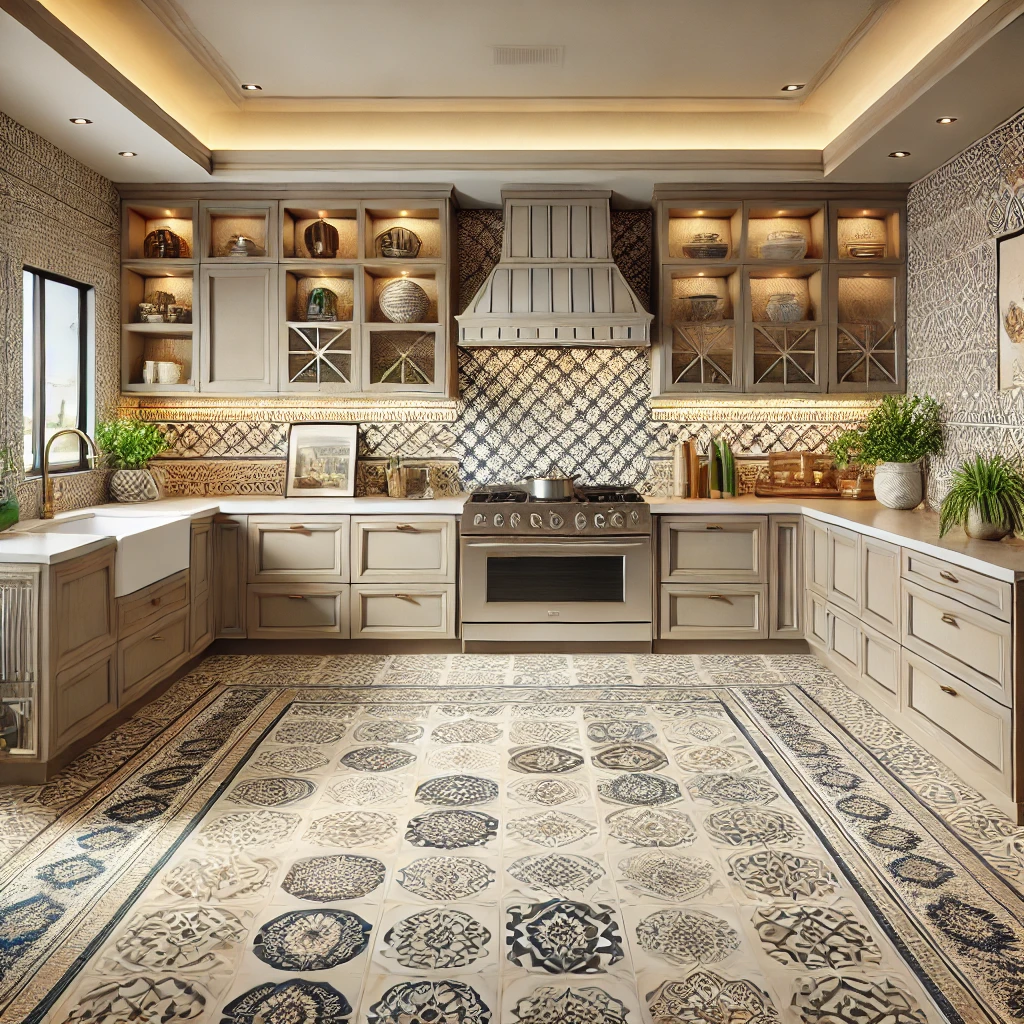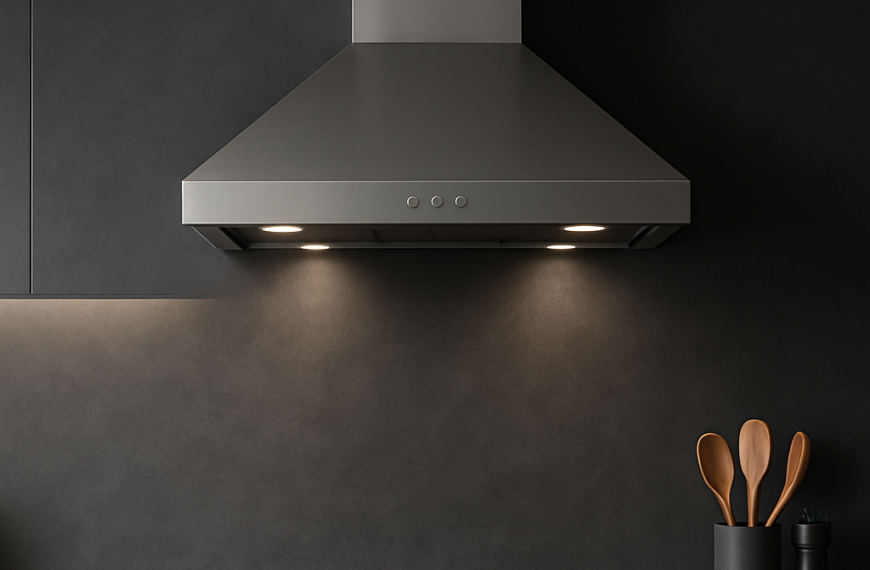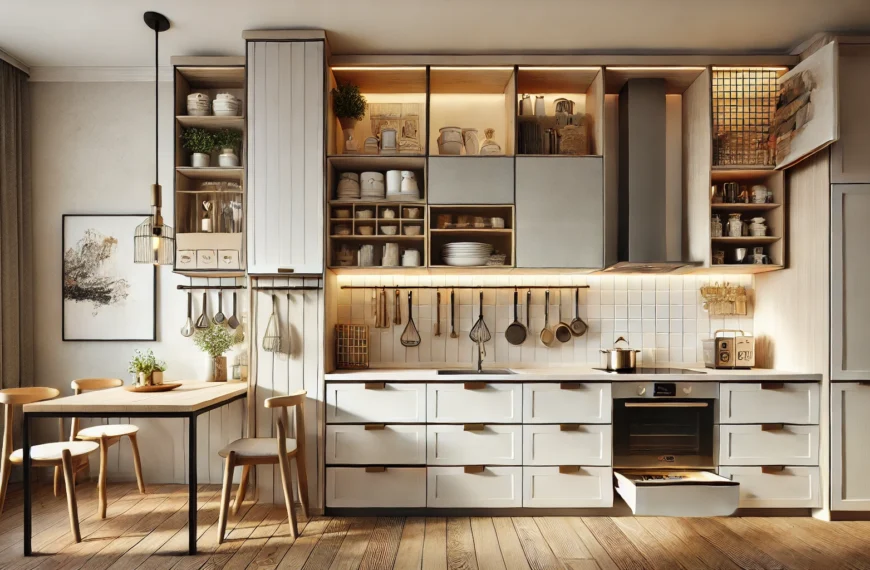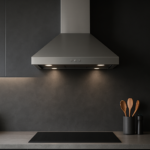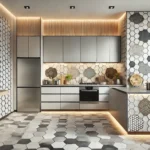A well-designed kitchen is essential for every home, and choosing the right kitchen tiles design in Pakistan plays a crucial role in enhancing its functionality and aesthetics. Tiles are not just decorative elements; they also contribute to the durability and cleanliness of the kitchen space.
The Importance of Choosing the Right Kitchen Tiles
The kitchen is a high-traffic area that experiences spills, heat, and heavy footfall. Selecting the right tiles ensures durability, easy maintenance, and a stylish look. The right kitchen tiles design in Pakistan can transform the entire feel of your kitchen, making it appear more spacious, elegant, or cozy depending on your choice.
How Kitchen Tiles Influence Interior Design of the Kitchen
Tiles play a vital role in the interior design of the kitchen by adding color, texture, and depth. Coordinating tiles with cabinetry, countertops, and lighting can create a seamless and well-balanced look. The right tiles also help define different zones within the kitchen, such as the cooking and dining areas.
Latest Trends in Kitchen Tiles Design in Pakistan
In Pakistan, modern kitchen designs are embracing neutral tones, geometric patterns, and glossy finishes. Popular trends include:
- Marble-look tiles for a luxurious feel
- Subway tiles for a classic and timeless appearance
- Matte-finish tiles for a sophisticated and slip-resistant surface
- Mosaic tiles for adding a creative touch
Understanding Different Types of Kitchen Tiles
Selecting the right type of tile depends on durability, aesthetics, and maintenance. Here are the most common types:
Ceramic Tiles: A Durable and Affordable Choice
Ceramic tiles are a popular choice due to their affordability and easy maintenance. They come in various colors, patterns, and textures, making them a versatile option for kitchen floor tiles design in Pakistan and backsplashes.
Porcelain Tiles: High-Quality and Stylish Options
Compared to ceramic tiles, porcelain tiles are more resilient to water and more long-lasting. They are perfect for both kitchen floor tiles design in Pakistan and walls, offering a sleek and polished look that lasts for years.
Glass Tiles: A Modern and Sleek Touch
Glass tiles reflect light, making kitchens appear brighter and more spacious. They are commonly used for backsplashes and accent walls, adding a contemporary touch to the interior design of the kitchen.
Marble and Granite Tiles: Luxurious and Elegant Designs
For those who prefer high-end finishes, marble and granite tiles offer sophistication and elegance. They require sealing but provide unmatched beauty and durability.
Mosaic Tiles: Creative and Versatile Solutions
Mosaic tiles allow for unique patterns and artistic expressions. They are ideal for adding vibrant touches to kitchen design studio in Pakistan projects and personalizing your space.
Kitchen Floor Tiles Design in Pakistan: Aesthetics and Functionality
Choosing the right kitchen floor tiles design in Pakistan involves balancing aesthetics with functionality. Here are key factors to consider:
Key Factors to Consider When Selecting Kitchen Floor Tiles
- Durability: Choose tiles that are resilient to high foot traffic.
- Water and stain resistance: Essential for easy cleaning and maintenance.
- Aesthetic appeal: The design should complement the overall interior design of the kitchen.
Slip-Resistant Tiles for Safety and Durability
Slip-resistant tiles prevent accidents, especially in busy kitchens. Textured surfaces or matte-finish tiles are great choices for safety.
Matte vs. Glossy Finish: Which One is Better?
Matte tiles offer a subtle and modern look with better slip resistance, while glossy tiles provide a high-end finish with easy cleaning but can be slippery when wet.
Color and Pattern Selection for Pakistani Kitchens
Neutral tones like beige, grey, and white remain popular, while bold patterns are trending for statement floors. Traditional motifs are also making a comeback in kitchen tiles design in Pakistan.
Wall Tiles vs. Floor Tiles: What’s the Difference?
Choosing the right tiles for walls and floors ensures a balanced look.
Choosing the Right Wall Tiles for Kitchen Backsplash
Backsplash tiles protect walls from splashes and grease while adding aesthetic value. Subway tiles, mosaic tiles, and glass tiles are excellent choices.
The Role of Floor Tiles in Kitchen Design
Floor tiles should be durable, easy to clean, and complement the kitchen’s overall theme.
How to Create a Harmonious Look Between Walls and Floors
Coordinating colors and patterns between wall and floor tiles creates a cohesive kitchen design. A kitchen design studio in Pakistan can help achieve the perfect balance.
Kitchen Design Studio in Pakistan: Professional Guidance for Perfect Tile Selection
A professional kitchen design studio in Pakistan can offer expert advice on selecting tiles that match your kitchen’s layout and aesthetic.
Why You Should Consult a Kitchen Design Studio in Pakistan
Experts help in selecting the right materials, colors, and finishes to enhance your kitchen’s beauty and functionality.
Services Offered by Kitchen Design Studios in Pakistan
- Tile selection and layout design
- 3D kitchen modeling
- Material sourcing and installation guidance
How Glow Your Home Can Help You Achieve the Perfect Kitchen Look
Glow Your Home provides top-quality kitchen tiles design in Pakistan solutions, offering a wide range of tiles to suit every budget and style.
Kitchen Tile Installation in Pakistan: Best Practices and Tips
Proper installation ensures long-lasting results.
Choosing the Right Tile Size and Layout
Larger tiles create a spacious look, while small tiles add intricate details. The layout should complement the kitchen’s dimensions.
Common Mistakes to Avoid During Tile Installation
- Not considering grout color
- Using the wrong adhesive
- Improper sealing of porous tiles
Maintenance and Cleaning Tips for Long-Lasting Tiles
- Clean regularly with mild detergents
- Avoid harsh chemicals that damage the surface
- Reseal natural stone tiles periodically
Budget-Friendly Kitchen Tiles Design in Pakistan
Affordable yet stylish options are available for every budget.
Affordable Tile Options Without Compromising Quality
Ceramic and porcelain tiles provide cost-effective yet durable solutions.
Where to Buy High-Quality Kitchen Tiles in Pakistan at the Best Prices
Local markets and online stores in Pakistan offer a wide variety of tiles at competitive rates.
DIY vs. Professional Tile Installation: Which is More Cost-Effective?
DIY can save money but requires skill, while professional installation ensures precision and durability.
FAQs About Kitchen Tiles Design in Pakistan
What Are the Most Popular Kitchen Tiles in Pakistan?
Marble-look, porcelain, and mosaic tiles are among the favorites.
How to Maintain and Clean Kitchen Tiles?
Use mild cleaners, avoid abrasive scrubbers, and reseal stone tiles.
What Tile Size Works Best for Small Kitchens?
Larger tiles create an illusion of space, while small tiles add detail.
Can I Use the Same Tiles for Kitchen Walls and Floors?
Yes, but ensure the floor tiles are slip-resistant and durable.
How Do I Make My Kitchen Look Bigger with Tiles?
Use light-colored, glossy tiles and a uniform pattern to enhance spaciousness.
By carefully selecting your kitchen tiles design in Pakistan, you can create a stylish, functional, and long-lasting kitchen that complements the overall interior design of the kitchen. With Glow Your Home, achieving your dream kitchen has never been easier!
